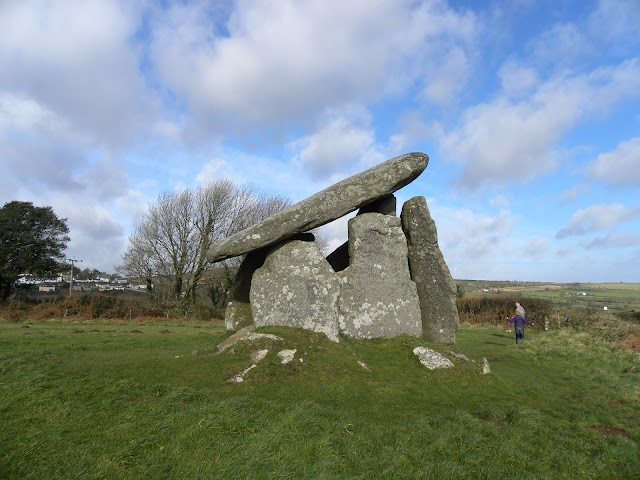The first one we saw is called King Doniert's Stone.
The stone is part of a medieval cross and was carved in the 9th Century. There are beautiful patterns carved on the stones and one of them has an inscription with the name of a Cornish King. This is why it is called the Doniert Stone. It is over 4 feet high
The other stone is called the 'Other Half Stone' and it is decorated with a carved plait.
The next stone monument we saw is called Trethevy Quoit and it is an ancient burial chamber. It is also from the 9th Century so it might be more than 2500 years old. It is made of 5 standing stones with a capstone on the top and is 2.7 metres high.
It would have been built to hold the remains of people who belonged to one of Cornwall's early farming communities. The capstone on the top weighs about 20 tonnes. The local people call Trethevy Quoit 'The Giant's House' because there is legend that says that giants hurled the stones together in a game of quoits. When it was first built it would have been surrounded by a mound of stones called a cairn and only the capstone on the top would have been visible.
The last place we visited was the Hurlers Stone Circles on Bodmin Moor. The hurlers are near a town called Minions which is the highest town in Cornwall. It was really, really windy when we got there.
The trees on the moor grow like this because it is so windy there a lot of the time.
The Hurlers are 3 circles made of standing stones. This is the only place in England where there are stone circles arranged in a line. As well as the circles, there are 2 stones that stand on their own and they are called the Pipers.
The legends says that the stones are men that were changed into stone because they played the game of hurling on a Sunday. The 2 stones called the pipers are men who played tunes on a Sunday so were turned to stone as well.
One circle has 15 stones but would have originally had 30. The middle circle has 14 stones and the last one has 9 original stones but most them have fallen down. All of the stones were hammered smooth.
We also saw the Cheesewring which is a pile of granite stones on the edge of a quarry. They were formed naturally by the weather on the moor. Because it was so windy and rainy we didn't go to the cheesewring, but Mum walked across the moor to have a look at it.















No comments:
Post a Comment